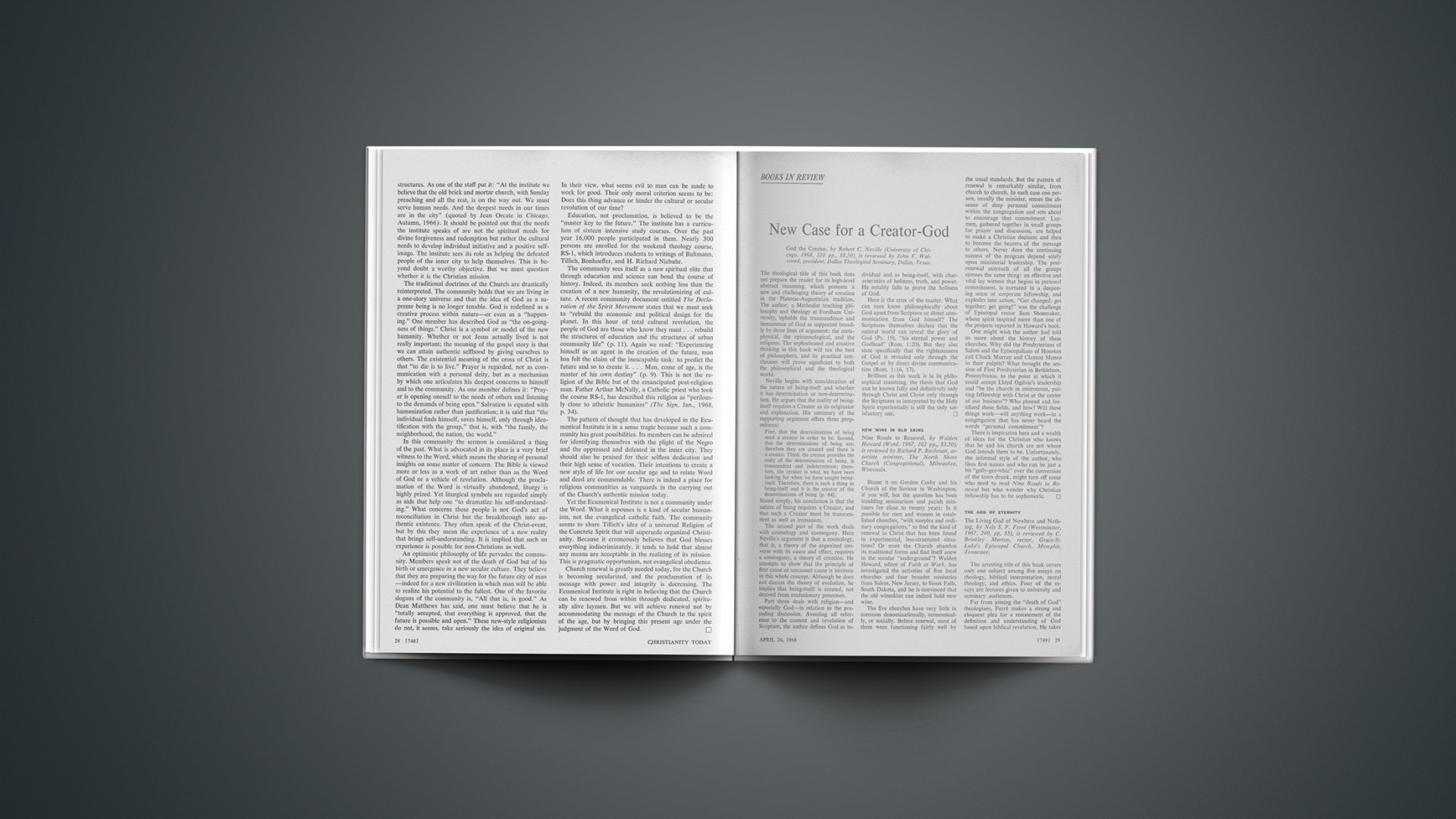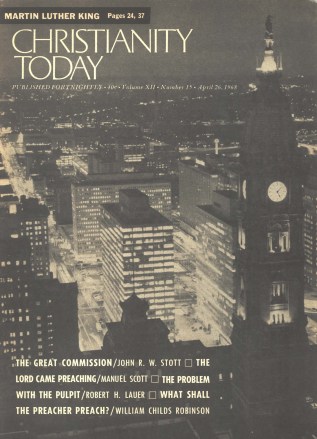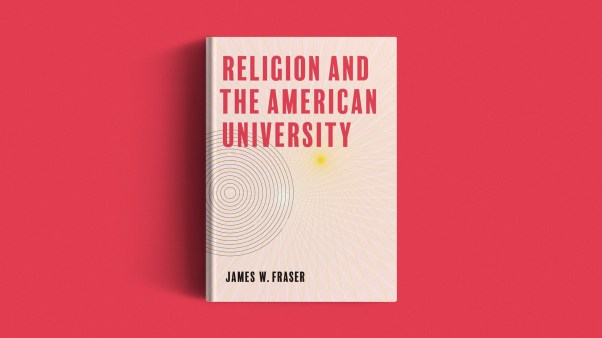New Case For A Creator-God
God the Creator, by Robert C. Neville (University of Chicago, 1968, 320 pp., $8.50), is reviewed by John F. Walvoord, president, Dallas Theological Seminary, Dallas, Texas.
The theological title of this book does not prepare the reader for its high-level abstract reasoning, which presents a new and challenging theory of creation in the Platonic-Augustinian tradition. The author, a Methodist teaching philosophy and theology at Fordham University, upholds the transcendence and immanence of God as supported broadly by three lines of argument: the metaphysical, the epistemological, and the religious. The sophisticated and creative thinking in this book will tax the best of philosophers, and its practical conclusions will prove significant to both the philosophical and the theological world.
Neville begins with consideration of the nature of being-itself and whether it has determination or non-determination. He argues that the reality of being-itself requires a Creator as its originator and explanation. His summary of the supporting argument offers three propositions:
First, that the determinations of being need a creator in order to be. Second, that the determinations of being are; therefore they are created and there is a creator. Third, the creator provides the unity of the determination of being, is transcendent and indeterminate; therefore, the creator is what we have been looking for when we have sought being-itself. Therefore, there is such a thing as being-itself and it is the creator of the determinations of being [p. 64].
Stated simply, his conclusion is that the nature of being requires a Creator, and that such a Creator must be transcendent as well as immanent.
The second part of the work deals with cosmology and cosmogony. Here Neville’s argument is that a cosmology, that is, a theory of the organized universe with its cause and effect, requires a cosmogony, a theory of creation. He attempts to show that the principle of first cause or uncaused cause is intrinsic in this whole concept Although he does not discuss the theory of evolution, he implies that being-itself is created, not derived from evolutionary processes.
Part three deals with religion—and especially God—in relation to the preceding discussion. Avoiding all reference to the content and revelation of Scripture, the author defines God as individual and as being-itself, with characteristics of holiness, truth, and power. He notably fails to prove the holiness of God.
Here is the crux of the matter. What can man know philosophically about God apart from Scripture or direct communication from God himself? The Scriptures themselves declare that the natural world can reveal the glory of God (Ps. 19), “his eternal power and Godhead” (Rom. 1:20). But they also state specifically that the righteousness of God is revealed only through the Gospel or by direct divine communication (Rom. 1:16, 17).
Brilliant as this work is in its philosophical reasoning, the thesis that God can be known fully and definitively only through Christ and Christ only through the Scriptures as interpreted by the Holy Spirit experientially is still the only satisfactory one.
New Wine In Old Skins
Nine Roads to Renewal, by Walden Howard (Word, 1967, 162 pp., $3.50), is reviewed by Richard P. Buchman, associate minister, The North Shore Church (Congregational), Milwaukee, Wisconsin.
Blame it on Gordon Cosby and his Church of the Saviour in Washington, if you will, but the question has been troubling seminarians and parish ministers for close to twenty years: Is it possible for men and women in established churches, “with steeples and ordinary congregations,” to find the kind of renewal in Christ that has been found in experimental, less-structured situations? Or must the Church abandon its traditional forms and find itself anew in the secular “underground”? Walden Howard, editor of Faith at Work, has investigated the activities of five local churches and four broader ministries from Salem, New Jersey, to Sioux Falls, South Dakota, and he is convinced that the old wineskins can indeed hold new wine.
The five churches have very little in common denominationally, economically, or socially. Before renewal, most of them were functioning fairly well by the usual standards. But the pattern of renewal is remarkably similar, from church to church. In each case one person, usually the minister, senses the absence of deep personal commitment within the congregation and sets about to encourage that commitment. Laymen, gathered together in small groups for prayer and discussion, are helped to make a Christian decision and then to become the bearers of the message to others. Never does the continuing success of the program depend solely upon ministerial leadership. The post-renewal outreach of all the groups stresses the same thing: an effective and vital lay witness that begins in personal commitment, is nurtured in a deepening sense of corporate fellowship, and explodes into action. “Get changed; get together; get going!” was the challenge of Episcopal rector Sam Shoemaker, whose spirit inspired more than one of the projects reported in Howard’s book.
One might wish the author had told us more about the history of these churches. Why did the Presbyterians of Salem and the Episcopalians of Houston call Chuck Murray and Claxton Monro to their pulpits? What brought the session of First Presbyterian in Bethlehem, Pennsylvania, to the point at which it could accept Lloyd Ogilvie’s leadership and “be the church in microcosm, putting fellowship with Christ at the center of our business”? Who plowed and fertilized these fields, and how? Will these things work—will anything work—in a congregation that has never heard the words “personal commitment”?
There is inspiration here and a wealth of ideas for the Christian who knows that he and his church are not where God intends them to be. Unfortunately, the informal style of the author, who likes first names and who can be just a bit “golly-gee-whiz” over the conversion of the town drunk, might turn off some who need to read Nine Roads to Renewal but who wonder why Christian fellowship has to be sophomoric.
The God Of Eternity
The Living God of Nowhere and Nothing, by Nets S. F. Ferré (Westminster, 1967, 240, pp. $5), is reviewed by C. Brinkley Morton, rector, Grace-St. Luke’s Episcopal Church, Memphis, Tennessee.
The arresting title of this book covers only one subject among five essays on theology, biblical interpretation, moral theology, and ethics. Four of the essays are lectures given to university and seminary audiences.
Far from joining the “death of God” theologians, Ferré makes a strong and eloquent plea for a restatement of the definition and understanding of God based upon biblical revelation. He takes to task substance theology (which he says is characteristic of Western thought), saying that to call God Being or even Supreme Being implies he is an entity, which, since he is God, he cannot be. God is, but he cannot be defined in any terms that would permit him to be finite; he can be defined only in terms of himself.
Ferré’s careful dissection of substance theology then leads him into an incisive appraisal of Whiteheadian process theology, which he holds at best to be only a bridge: “Non-being as an ultimate is hard to stand on.” Modern thinkers, he says, have largely failed to find meaning in the ultimacy of God and the reality of the Resurrection. He pleads for a “right understanding of the Christian faith,” which for him is the fundamental concept that the God of “nowhere and nothing” is precisely the God of the Bible, “who, as Spirit, the Infinite, is nothing and nowhere, no event in space time; and therefore is the living God of eternity.” The God of Christianity is not subject to diminution or relegation to anything less than ultimately infinite.
His discussion of Christology is likewise an appeal to biblical foundations, and a rejection of myth. He affirms belief in the historicity of the Incarnation and the reality of Jesus as Son of God: “in this man, Jesus of Nazareth, we encounter the reality, the will and work of God.”
Many readers may be less than satisfied by his distinction between Jesus as God and Jesus as Son of God. Although he reaffirms belief in “the transcendent living God and … his triumphant being and working in Christ for our salvation,” Ferré holds that by equating Jesus with God, we undermine his full humanity and his full relevance for us. Liturgical failure to make this distinction between Jesus as God and Jesus as Son of God, he says, leads to misdirected piety and a substitution of myth for Gospel.
His essay on “The Bible and the Book of God” urges that Christians read the Bible as an essential part of their discipleship and growth, and that it be used in a reasoned way, free from both the strictures of literalism and the abuses of extreme criticism (e.g., that of Bultmann).
Ferré assails traditional structures of moral theology, such as objective standards of moral conduct and the doctrines of conscience, by calling them “moralism” and not “morality.” His praise of situation ethics is not persuasive, in the light of the clear teachings of Scripture. No evidence is adduced to show that the Ten Commandments have been repealed, or even amended.
Ferré sees the answer to social and political concerns in an evolving “democratic socialism,” akin to that of Britain but with, he says, a greater freedom of choice. He sees the Great Society as a valid expression of the will of the people, provided it is not destroyed by “a militarily dominated foreign policy.” His evaluation of Communism and its threat to Christianity and to freedom is naïve and apparently oblivious to the historical record of Communism’s brutal methods and openly announced goals of world domination.
In several significant areas this book gives encouragement to a new direction in theology that is actually a reaffirmation of a genuine biblical view of God and of the Incarnation. This can only be salutary. His moral theology and ethics ally him with the avant-garde thinkers in these fields. Orthodox Christianity can scarcely be expected to engender much enthusiasm for the new morality, which contradicts both Old and New Testaments. Ferré does, however, present the case for both social involvement and the new morality in a clear and concise way.
Reading For Perspective
CHRISTIANITY TODAY’S REVIEW EDITORS CALL ATTENTION TO THESE NEW TITLES:
• The Progress of the Protestant, by John Haverstick (Holt, Rinehart, and Winston, $14.95). Haverstick presents highlights of Protestant history from Wycliffe to Barth through 500 illustrations and a limited but lively text.
• After You’ve Said I Do, by Dwight Hervey Small (Revell, $4.95). An experienced pastor-lecturer-counselor offers enlightening insights from the Bible, scholarship, and life on the complex problems of communication in marriage.
• … And Thy Neighbor, by Sam Shoemaker, edited by Cecile Offill (Word, $3.50). A sampler of sermons and writings by the late Dr. Sam Shoemaker that stresses the revolutionary spiritual power in the New Testament message and calls men to a victorious life of faith in Christ.
Jonathan Edwards As Social Prophet
Jonathan Edwards and the Visibility of God, by James P. Carse (Scribner’s, 1967, 191 pp., $4.50), is reviewed by Robert G. Clouse, associate professor of history, Indiana State University, Terre Haute.
Jonathan Edwards, philosopher and mystic, evangelist and theologian, stands out as one of the greatest figures in the intellectual life of America. Professor Carse, who teaches in the Department of Religious Studies at New York University, presents Edwards as relevant to the entire American experience. He points out that by Edwards’s time the people of his homeland were not spiritual seekers but businessmen interested in material gain. Religion, through the efforts of those who taught the Half-Way Covenant, had become mostly an inward, private affair that failed to challenge social sins. Edwards denounced this type of Christianity by insisting that a man’s faith must be demonstrated by its visibility and its beauty.
This emphasis upon a meaningful regeneration and a life of visible sainthood had a special importance in America, for that nation was to lead the world in the establishment of universal peace and justice. Edwards selected his themes from the Christian tradition in order to encourage his hearers to practice their faith and build the ultimate society. This ideal of the millennial kingdom was more important to him than his Puritan or Calvinist heritage.
The failure of Edwards is an ominous prediction of the direction of American society, says Carse, for today we still continue to separate our social goals from our personal behavior. All the high-sounding speeches of American religious leaders and politicians remain meaningless unless they are translated into a visible style of life. As Carse states:
What Jonathan Edwards preached and wrote in all of his sermons was a radical this-worldliness. It is for this reason that the failure of Jonathan Edwards is a fact of no small significance in the American civilization. After Edwards every great American prophet would fail in the same way. The American journey is over. Let the dream of the ultimate society be spoken in public ceremonies, but never dispatch the will and the intelligence in the active attempt to achieve it. The ship is at anchor, the sails down [p. 162]
One must praise Carse for his social views. In several places he brings in the many problems that face our society today. On the other hand, one may question whether it is justifiable to update Edwards in this way. The book seems less an explanation of Edwards’s thought than a series of clever sermons on social justice. Although it may be difficult to discover the “real Edwards,” Carse should have made a more strenuous and more objective attempt. Close attention to Edward’s place in the Calvinist theological tradition would have been welcome. The prologue to this book includes a discussion of some of the historiographical views of Edwards, and Carse announces that he will avoid this type of “museumship.” It appears that he has, at the expense of historical accuracy and objectivity.
Blame It On Augustine
Memory and Hope, by Dietrich Ritschl (Macmillan, 1967, 237 pp., $5.95), is reviewed by Donald W. Burdick, professor of New Testament, Conservative Baptist Theological Seminary, Denver, Colorado.
Late twentieth-century Christendom is confronted with the baffling phenomena of a godless Christianity (the God-is-dead speculation) and a morality without objective standards (the “new morality”). Where did these seemingly self-contradictory ideologies come from? In Memory and Hope Dietrich Ritschl proposes the somewhat surprising answer that they are the belated fruitage of the theology of Augustine, the beloved bishop of Hippo. Ritschl, who is professor of systematic theology at Pittsburgh Theological Seminary, says that at the very heart of the current impasse in theology there lies a fallacious concept of Christology. The proper beginning of theological thinking is not the Scriptures, nor the Incarnation, nor the historical Jesus, nor the historical-risen Christ, but the Christus praesens, the Christ who is present here and now. Writing in a style that is often oblique and indirect, Ritschl says he would replace the traditional two-nature, incarnation-oriented view of Christ’s person with a subjective, experience-centered “Christology of call and response” that springs from the concept of the Christus praesens.
And what does he mean by this old Latin phrase? He explains that the Christus praesens is “that” in Yahweh which was seen in the man Jesus, “God’s Heart,” “God’s guts,” which is set upon working and suffering in man’s behalf. It is God’s identity throughout all his changing history. In another place Ritschl employs the term “modalism” in declaring that the Holy Spirit is the Christus praesens.
No one would deny the importance of relating theology to the worship of the here-and-now-present Christ. Theologians, and for that matter Christians in general, are in danger of substituting theological definitions for Christ as the object of worship and praise. Worship, however, demands a personal object, and it is doubtful if Ritschl’s Christus praesens really is personal. Furthermore, in trying to retain the present Christ as proper object of worship one need not discard propositional definitions, as Ritschl seems to do.
Although the author speaks highly of the value of exegesis for theology, his new Christology is sadly lacking in this regard. His description of the Christus praesens as God’s identity, as God’s heart, and as the Holy Spirit fails to reckon seriously with such statements as that in John 14, “I will pray the Father, and he will give you another Counselor …, even the Spirit of truth.…” Here is no identification of Father, Son, and Spirit; here is no modalism; here are three distinct identities.
Furthermore, to ground Christology, and ultimately theology, on the experience of the Christ who is here and now present is hopelessly subjective and therefore without adequate foundation. Theology, in this case, no longer rests on the authority of divine declaration. Every man, as in the period of the Judges, is in reality free to make those theological decisions that are “right in his own eyes.”
Tribute To Two Theologians
Harnack and Troeltsch: Two Historical Theologians, by Wilhelm Pauck (Oxford, 1968, 160 pp., $5), is reviewed by Bernard Ramm, professor of systematic theology, California Baptist Theological Seminary, Covina.
One problem of all scholarship is that recent and current leaders tend to blot out or hide some of the great figures of a previous age. This has happened to Harnack and Troeltsch, who represented German theological scholarship at its best in their day. Such names as Brunner, Bultmann, Gogarten, Barth, Thielecke, and Heim have eclipsed these giants of a previous generation.
Pauck attempts to rekindle knowledge of these men and the proper admiration and credit for them. He studied under Troeltsch, and he gives us a warm, sympathetic, and accurate representation of both men. He discusses them biographically, traces out their academic careers, indicates their greater writings, and notes the honors that came their way. The book has an unusual conclusion: an extensive tribute of Troeltsch to Harnack, and Harnack’s funeral address for Troeltsch.
Both men were outstanding lecturers. Modern educators almost uniformly accuse lecturing of being an obsolete, inefficient means of teaching. They would have a hard time pinning this rap on Harnack and Troeltsch, both of whom lectured with great style and amazing effectiveness to student audiences of up to a thousand.
They were also great authors. We are still in debt to Harnack for his great work, The History of Dogma, and his brilliant summary of the liberal view of Christianity in What Is Christianity? Harnack could read a Greek or Latin page, walk into the lecture room, and reproduce the page on the blackboard. Our seminaries still have high on their ethics reading list Troeltsch’s The Social Teachings of the Christian Church.
Pauck’s treatment is very sympathetic and non-critical. In view of the development of neo-orthodox theology and the newer studies in biblical theology, the evangelical must simply state that the basic presuppositions of Harnack and Troeltsch were defective. We can use these men and respect their learning. However, we must retain the right to be critical of them. We cannot follow today Harnack’s reconstruction of the Christian Gospel in What Is Christianity? Nor can we say that the historic Christian theology of the incarnation and the trinity is nothing but the intrusion of Greek metaphysics into the Christian Church. In fact, some scholars today would say that the Fathers’ use of Greek terminology in theology showed the amazing ability of the Christian Church to adapt its theology to its culture in a dynamic way without losing the original biblical substance.
Sex Education In The Church
The Concordia Sex Education Series, W. 3. Fields, editor (Concordia, 1967, $11.30): I Wonder, I Wonder, by Marguerite K. Frey (for kindergarten—grade 3); Wonderfully Made, by Ruth S. Hummel (for grades 4–6); Take the High Road, by August J. Bueltmann (for junior high); Life Can Be Sexual, by Elmer N. Witt (for high school); Parents’ Guide to Christian Conversation About Sex, by Erwin J. Kolb; and Christian View of Sex Education, by Martin Wessler (for pastors, teachers, youth workers, and parish planners), are reviewed by Linda A. Boice, housewife and former teacher, Arlington, Virginia.
Does the Church have a role in the “sex revolution”? Is there a Christian view of sex? Should Christian parents and teachers give detailed sex instruction to children under their care? Should these questions even be discussed by Christian educators? Yes, answer the editor and authors of this unique series, published under the auspices of the Board of Parish Education of the Lutheran Church-Missouri Synod.
Citing such sociological evidence as the rising divorce rate (one out of every six marriages), the incidence of marital infidelity (20 per cent in the United States), and the startling increase in illegitimacy, illegal abortions, and homosexual activity, Wessler presents a strong case for the view that the obvious sexual illness of our country is a manifestation of America’s deeper spiritual malady. “It is significant to note that as individuals lose sight of the divine dimension of life, they also lose perspective on sex, which is subject to so many secular distortions.”
The authors start with man’s nature as God’s creature, created for fellowship with his Creator, and as a sexual being able to relate to other sexual beings. Maintaining that sex, as part of God’s creation, was pronounced “good” by God himself, they seek to present an integrated view of the human personality, corrupted by sin and in need of Christ’s redemption. Christ can restore both the divine-human relationship and the man-to-man and man-to-woman relationships that sin has badly distorted.
The first four books are, in the publisher’s words, “the first graded program for ages 5–15.” In colorfully illustrated formats that will appeal to children, they seek to convey “much more than merely the biological facts of reproduction education.” According to Kolb, “This series of books is more concerned with the development of positive, Christian attitudes toward sex and with assisting boys and girls, men and women in fulfilling their roles as Christian boys and girls and Christian men and women.” The point of view is consistently biblical. The framework for all discussion is that we are “fearfully and wonderfully made,” and that our sexuality, like every other aspect of our lives, is a gift from God to be understood as part of his plan. It is to be used, not abused, for his glory.
Two volumes for teen-agers (Take the High Road, Life Can Be Sexual) deal frankly with the adolescents’ expanding sexual awareness and involvement. The authors face the problems with honesty but reject the new morality and instead present the God-ordained morality of the biblical writers. They claim that full sexual fulfillment and happiness can only be had within the marriage relationship.
One criticism that will be raised is that while those contemplating interfaith marriages are cautioned about the added adjustment problems involved, no reference is made to what many feel is a clear biblical injunction against the union of God’s people with those who do not find Christ’s redemption at the core of their lives. Since the series stresses the need for committed Christian parents to train children in Christian attitudes, this omission presents a problem. Kolb states that “the child’s attitudes can, however, be Christian only when the child himself is a Christian. This should always be the parents’ primary concern.… For this they must bring the child into a living and vital relationship with Jesus Christ.” A Christian parent would presumably find this task very difficult if his partner did not share his concern.
Five of the books have a glossary of terms, and the last four in the series contain well-chosen suggested reading lists. Four related filmstrips with records are available. In all, this is a carefully planned and attractively executed curriculum, one that can be highly recommended to all concerned about acquiring for themselves and passing on to today’s youth a sound knowledge of sex and a Christian attitude toward it.
Is ‘Sola Scriptura’ Deficient?
Tradition and Traditions, by Yves M.-J. Congar (Macmillan, 1966, 519 pp., $14.95), is reviewed by Ralph P. Martin, lecturer in New Testament studies, University of Manchester, England.
Scripture, Tradition, Church: these are the three leading themes in this large, erudite, two-part work by a prominent Roman Catholic theologian from Strasbourg. All Christians concede that these terms denote sources of religious authority; but the question spotlighted throughout this book is: Which principle of authority has rightful claim to precedence and autonomy?
Much of Fr. Congar’s treatment is a historical study. He carefully describes the meaning and value of ecclesiastical tradition in its twofold connection with Scripture and the Church, from the New Testament period through the Fathers on to the Reformers and the Tridentine response of the Counter-Reformation and up to the most recent Protestant discussions of the World Council. He cites the authorities with ample reference, and this part of the study evokes our admiration and gratitude. It is a monumental survey and of great worth, even if some conclusions drawn from the New Testament and patristic data are far-fetched.
Congar writes, however, both as a polemicist and as a historian of dogma. In this first role his appeal is directed to “our separated brethren,” whose ignorance he seeks to dispel. His position is briefly that Scripture by itself is not sufficient as a rule of authority and needs “to be completed by another part … of the same deposit” of truth which derives from apostolic times. This link between Scripture and Tradition as two ways, two modes in which the apostolic deposit comes to us in its plenitude and authenticity is “the basis of the Catholic idea.” And though he strives to maintain that no second source of authoritative teaching is intended in the Roman Catholic dogma of Tradition and grants that “Scripture and Tradition are not on the same level; Scripture has an absolute sovereignty,” the thrust of his argument is that Scripture alone remains a deficient principle. The right of private interpretation—one of the stoutest planks in the Reformers’ platform—is denied in deference to the teaching office of the magisterium.
This book will challenge current Protestant thinking. What do we mean by the watchword sola scriptura? Does Protestantism link the Christian life to the Bible rather than to the living Christ, or is this a false impression we have given and so a caricature of the Reformed faith? What function did the apostles play in early Christianity, and was P.T. Forsyth right when he declared that their successor was not the episcopate but the New Testament?
Conger would do well to gain an understanding of the Bible that would lead him to see it as the authoritative written Word of God.
For The Still Hour
Holy Common Sense: The Lord’s Prayer for Today, by David H. C. Read (Abingdon, 1968, 96 pp., $2.50), and Finding Meaning in the Beatitudes, by John A. Redhead (Abingdon, 1968, 112 pp., $2.50), are reviewed by Ralph G. Turnbull, minister, First Presbyterian Church, Seattle, Washington.
Two books of sermons to read, and in a short time! This was a strenuous assignment but one that gave a strong feeling of the thrust and pulse of the two authors. The subject matter was first preached to persons who were listening for some new word from God, and so to think as a worshiper while reading these books is helpful. They deal with very familiar themes. What new thing can be said about the Lord’s Prayer or the Beatitudes? How does one interpret a masterpiece? The proper response to these masterpieces is to gaze and ponder, then believe and act!
Yet in these two slim books the age-old truths and familiar words are brought to bear upon the needs of today. In an age that takes pride in its disbelief, the Christian faith is just as related to common life as it ever was. To realize that prayer is just the commonsense way of talking with God is to find a key to this treasure. To see the Beatitudes as a way of living is to upset one’s selfish complacency.
In these books we find the wisdom of experienced preachers, the faith of wholly convinced believers, the clear exposition of careful scholars, and the flowing style of disciplined writers. Each preacher illustrates well and with deft touches appeals to our day. Each stresses the absolutes of our Lord’s teaching, thus unveiling ideals and ethical norms in which are found the sanctions of divine authority for life. The call is given to march with Christ and with the noble army of those who still pray the prayer that teaches us to pray and who still attempt to live by the disciples’ standard of excellence.
These are books for the still hour; Christians at every stage of growth can profit from them.
Book Briefs
Problems and Perspectives in the Philosophy of Religion, by George I. Mavrodes and Stuart C. Hackett (Allyn and Bacon, 1967, 512 pp., $8.25). An excellent college textbook of readings that introduce the student to the principal questions of the philosophy of religion.
Suffering, by T. B. Maston (Broadman, 1967, 87 pp., $2.50). In his eleventh book, this Baptist professor emeritus of Christian ethics gives his personal perspective on suffering based on knowledge from the Bible and his own experience.
Living the Great Adventure, edited by Richard Engquist (Word, 1967, 206 pp., $3.50). Honest narratives of personal spiritual crises and conversions selected from the pages of Faith at Work.
Redeeming the Time, by James V. Schall (Sheed and Ward, 1968, 244 pp., $5.50). A Catholic scholar attempts to synthesize ideas found in contemporary literature, secular theology, and biblical doctrine in order to show the relevance of Christianity for modern men. He partially succeeds.
When the Rain Falls, by Herschel H. Hobbs (Baker, 1967, 89 pp., $2.95). Inspiring, biblically based essays that offer comfort and hope to people undergoing hardship. A fine gift for those who suffer.
World Christian Handbook 1968 (Abingdon, 1967, 378 pp., $7.50). Authoritative statistics on denominations and missions in every nation.
Christian Ethics, by Isma’il Ragi A1 Faruqi (McGill University, 1967, 333 pp., $12). A Syracuse University professor’s plea for a return to Jesus as “mouthpiece for the Holy and exemplification of the moral law,” but in terms of a Neo-Protestant-Islamic refusal to recognize him as incarnate God.
Paperbacks
The Art of Teaching Christianity, by Wayne R. Rood (Abingdon, 1968, 224 pp., $2.75). Provides teachers—whom Rood calls “enablers of dialogue”—with some good insights and methods for involving learners in the communication that takes place between God and man.
Revolution in Evangelism, by W. Dayton Roberts (Moody, 1967, 128 pp., $1.25). Tells the story of Kenneth Strachan’s Evangelism-in-Depth experiment, first developed in Latin America. Recommended.
Toward Christian Maturity, by Samuel Southard (Standard, 1967, 112 pp., $1.25). Southard applies biblical teaching and psychiatric principles to problems of Christian living.
The Old and New Man, by Rudolf Bultmann (John Knox, 1967, 79 pp., $1.50). Bultmann discusses Paul’s view of ethics in Galatians 5:25, man in Romans 7, and Adam and Christ in Romans 5. Challenging reading.










